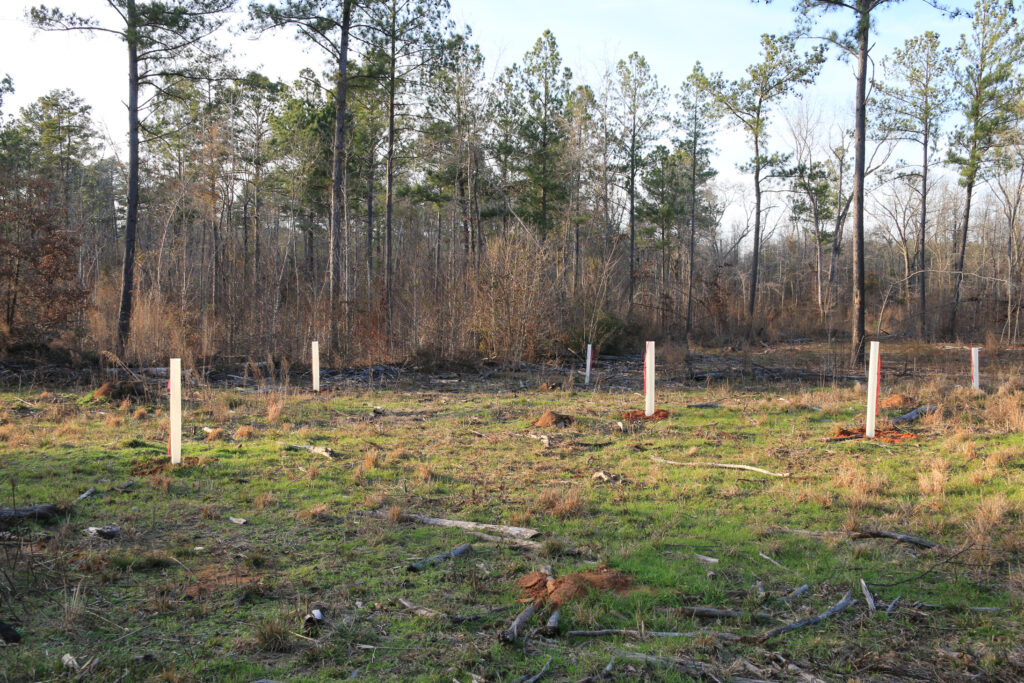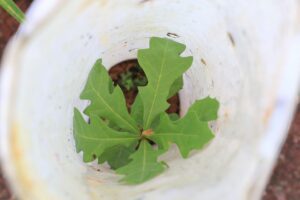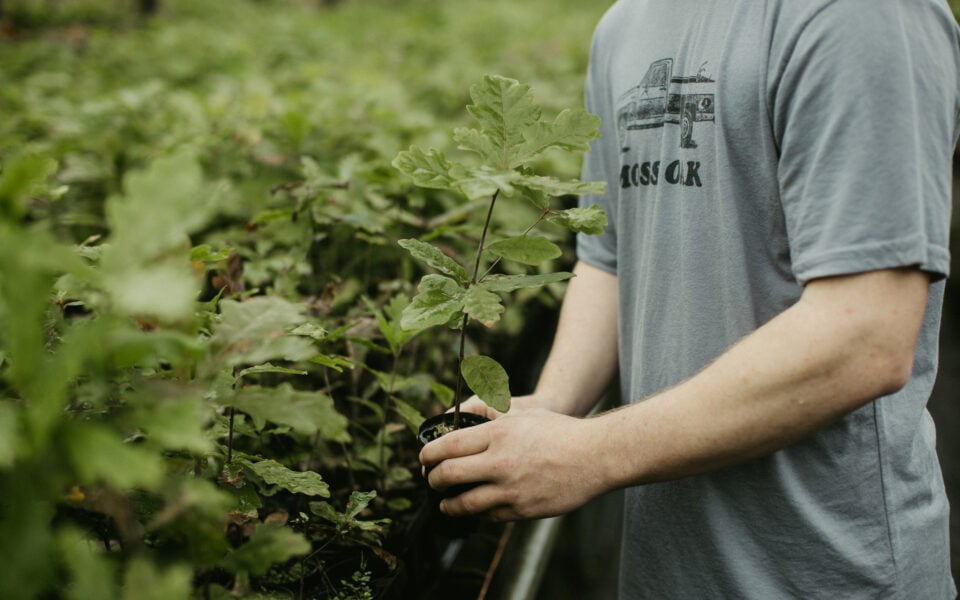When a hunter normally thinks about food plots they often think of soybeans, clover, grains, brassicas, corn, and various seed mixes. Many managers often do not think about considering the trees by removing less desirable trees that have little or no value to wildlife, and replacing them with those that benefit your preferred wildlife species. This creates what I like to call a “long term food plot” that will typically last long beyond the life of the person planting them.
We are currently undertaking this process on our land in Georgia. When we had our pines thinned, we also had all sweetgums cut. In one area that had little oak diversity, which was dominated by water oaks (Quercus nigra), we had all of the water oaks removed from a portion of the property. We could do this since we also had water oaks in the areas nearby that could not be cut, so we were not removing all the water oaks. This created an opening of about 2 acres. We also created another large opening that was primarily sweetgum trees. This opening was about an acre in size.
At first, we considered creating food plots in these two areas, but after surveying what trees we now had on our land, I noticed that the oaks that we had were only water oaks, northern red oaks (Quercus rubra), and white oaks (Quercus alba). We really did not have much variety at all in the oak family. I was able to determine this by walking around with two of my tree identification books. One book that I used was the National Audubon Society’s Field Guide to Trees Eastern Region. Wilbur H. Duncan and Marion B. Duncan wrote the other book, Trees of the Southeastern United States. You can find similar books for the area where your land is located. You can also download field guidebooks to your P.C. or tablet if you have one that you can carry with you. Along with my recent research I had been doing learning about trees, I felt that increasing the variety of oaks would be better than adding two more food plots.

The question then became “what oaks, and other trees to plant?” I felt we were white oak dominate on our land overall. Deer love white oaks due to their lower tannic acid, and as a result, deer hunters love white oaks. However, having diversity is important on a piece of property. It helps to overcome drought, late frost, insects, and other obstacles to acorn production. We decided to add oaks from the red oak family, so I needed to select which red oaks I wanted.
The first tree that I wanted to add was the Shumard oak (Quercus shumardii). For those that are not familiar with the Shumard, they are an oak that is tolerant of a range of soil pH and climates. They tend to start to produce acorns around 25 years of age, and they have a large acorn. They also provide quality lumber when that time comes. Even though that is not our primary reason for planting any of the oaks we selected, it is an added bonus that I might not benefit from, but my children could. I have also noticed that when white oak acorns start to become scarce, deer tend to like Shumard oaks on other properties that I have hunted.
The second tree I wanted to add was the nuttall oak (Quercus nuttallii). I had heard from hunters in the Mississippi Delta region, and read numerous magazine articles and journals talking about the longevity of nuttall oak acorns. Near the parking lot of the school where I teach, we planted several nuttalls. At the time, I had no idea what they were, but as I began to expand my knowledge of the various types of oaks, I realized what we had planted.
 Nuttalls are also a fast growing oak. They have the advantage of producing acorns very early, ranging from 8-15 years. The nuttalls at our school started producing when they were 10-12 years old. The main reason I wanted to add this oak to our land was the length of time that the acorns remain on the tree. Once all of the other acorns have been on the ground and have all but disappeared, the nuttall will just start to drop. The trees at the school will usually not drop their first acorn until mid to late December, with most falling in January and February. This is not only a great way to attract and hold deer on your land late in the season, but also a great food source to help sustain your deer herd when other food sources are hard to come by outside of food plots. Nuttall oaks also produce quality lumber.
Nuttalls are also a fast growing oak. They have the advantage of producing acorns very early, ranging from 8-15 years. The nuttalls at our school started producing when they were 10-12 years old. The main reason I wanted to add this oak to our land was the length of time that the acorns remain on the tree. Once all of the other acorns have been on the ground and have all but disappeared, the nuttall will just start to drop. The trees at the school will usually not drop their first acorn until mid to late December, with most falling in January and February. This is not only a great way to attract and hold deer on your land late in the season, but also a great food source to help sustain your deer herd when other food sources are hard to come by outside of food plots. Nuttall oaks also produce quality lumber.
The third tree I wanted to add to our land was the southern red oak (Quercus falcata). We mainly had northern red oaks, and I had noticed deer preferred the acorns from the few southern red oaks we had on our land. Southern red oaks are also adapted to growing in the soil in the majority of the areas that we had cut to create our long term food plots. I also like the smaller size of the acorns for turkeys. It also would add to the diversity of oaks that we wanted. Like our other selections, southern red oaks are known as a great lumber producer.
The one white oak that I added to our land was the swamp chestnut. Being a white oak with low tannic acids, its acorns are highly preferred by deer and turkey. White oaks are a tree that we planted in lower areas on our land because as part of the name implies (swamp) they tend to prefer lowland areas where we primarily had only water oaks. The swamp chestnut oak is one of the oaks in the white oak family that produces quality lumber.
We also added 4 chestnut trees to the upper edge of one of the areas. I selected this tree not only for the value of the nut for the wildlife, but I would love to be part of reestablishing this once abundant tree. I have read stories and seen the images of the giant chestnuts that once thrived in the Appalachian Mountains. The story of their comeback and all the work that has gone into it has greatly impressed me. I also look forward to sampling some of the chestnuts myself.
A second non-oak variety we added were mulberries. Even though turkeys will likely not eat the fruit from these trees during turkey season and definitely not during deer season as they ripen late May into June, it adds to the diversity of food available to the wildlife on our land. They will also produce a great snack for us as we are doing our late spring early summer habitat work on our land.
 We planted the trees in late February and early March on our land in Georgia to take advantage of the spring rains. We wanted to establish the trees before the summer drought and heat set in. The trees were planted in a grid approximately 25 to 30- feet apart. This would provide the trees with room to grow without becoming overcrowded.
We planted the trees in late February and early March on our land in Georgia to take advantage of the spring rains. We wanted to establish the trees before the summer drought and heat set in. The trees were planted in a grid approximately 25 to 30- feet apart. This would provide the trees with room to grow without becoming overcrowded.
To make life easier and be able to complete the task over the weekend, we planted the trees with an auger implement on our tractor. We also placed stakes at each tree and used tree-tubes. With some of the first fruit trees and chestnuts that we planted, we used black plastic drainpipe. I can say that both work, but the trees planted in the trees tubes seem to, at this time, have grown better than those in the black drainpipe.
To keep competition down from weeds and other trees, we also made sure that where we planted the oaks, we would be able to get the tractor with the bushhog around them. We learned that lesson the hard way when planting fruit trees the previous year. We also went in and disked the areas where we could and planted clover and oats to create temporary food plots until the oaks become large enough to shade out the food plot. We also went around with a hand sprayer and sprayed an area about 3-feet in diameter around the trees. In that 3-foot diameter, I added tree fertilizer each year after the trees had been planted. Currently, most of the trees have grown 12 to 20-inches each year, showing more growth once the root systems were established.
Each of these trees can be purchased from various nurseries including Mossy Oak Nativ Nurseries. I feel that it is important to purchase your trees from a reputable, regional nursery. I have learned this lesson from others, who in order to save a few dollars went with nurseries that had insects or diseases in the trees they were sold and died after planting. I have also helped others to plant trees that were severally root-bound, which is when the tree has been left in a container that is too small for the size of the root mass of the tree. The roots start to grow around each other in the container, which can result in a tree that might take longer to reach its potential, and should be corrected prior to planting to give the tree its best chance to survive.
Creating a “tree plot” is not a project that produces immediate results. This habitat management process takes years to generate results. However, the positive is once the process has been set into motion, it will produce food for wildlife for generations.
 Start by surveying the trees that you have on your land. Then, make a decision about which trees you would like based on the trees you believe may be missing. Which will help you to meet your management goals? What species will do best in your soil and growing conditions? Then decide which trees should be removed to make room for those trees you have decided to plant.
Start by surveying the trees that you have on your land. Then, make a decision about which trees you would like based on the trees you believe may be missing. Which will help you to meet your management goals? What species will do best in your soil and growing conditions? Then decide which trees should be removed to make room for those trees you have decided to plant.
If you prefer, you can also hire a forester to help with this process. Have those trees cut that you would like removed. You can do this yourself if you plan to clear only a small area, but if it is part of a larger timber management plan, you’ll probably want to look at having a timber company to cut the trees. The money you receive from this process can pay for the trees you plant, and even the tractor and implements you may need to plant and maintain the trees. Once you have decided on the trees you would like to add, and have cleared the planting site, select a reputable nursery from which to purchase your trees. Then after planting it is just a process of maintenance, and letting the trees and Mother Nature do the rest.
I hope that this has inspired you to look at “food plots” in a different light, and to take the time to look at the trees that you have on your land and their value to the wildlife that call it home. With some work up front, you will be able to sit back and watch your hard work grow, and one day you may be sitting in a stand in one of those trees you planted, watching deer and turkey feed on the acorns your trees produced.
Join our weekly newsletter or subscribe to GameKeepers Magazine.
Your source for information, equipment, know-how, deals and discounts to help you get the most from every hard-earned moment in the field.







